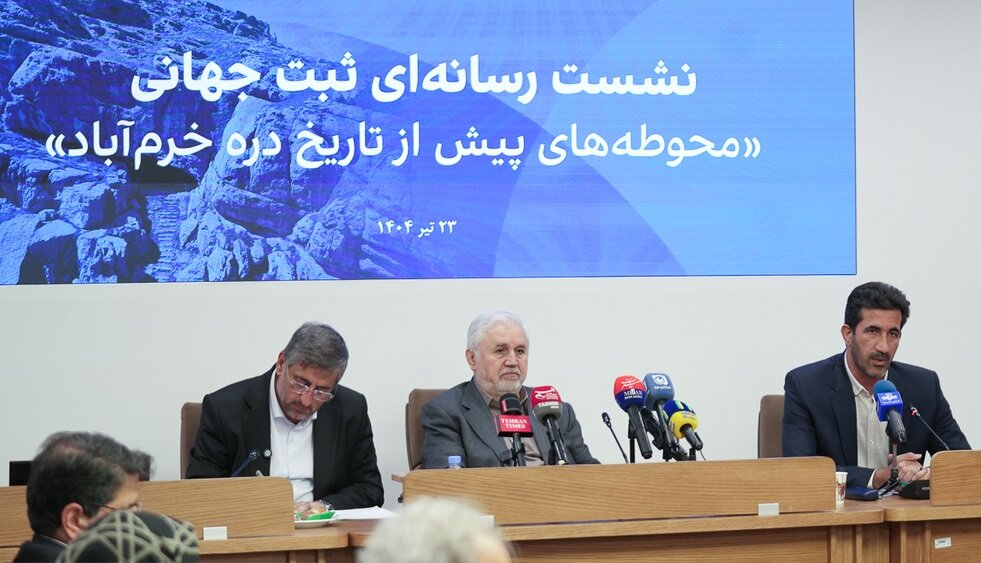Iran’s recent UNESCO label was a combined effort of archaeology and cultural diplomacy

TEHRAN – Iran’s latest addition to the UNESCO World Heritage list highlights a successful blend of archaeology and cultural diplomacy, which helps promote the nation’s rich historical and cultural legacy, officials said on Monday.
At a press conference held at the Ministry of Cultural Heritage, Tourism and Handicrafts on Monday, the recent inscription of the Prehistoric Sites of the Khorramabad Valley in western Iran was discussed by the governor-general of Lorestan province, along with several experts and officials from related fields.
Ahmad Pakatchi, Iran’s ambassador to UNESCO, praised the inscription as a product of expert archaeological work paired with effective cultural diplomacy.
Speaking via live video link, he remarked, “The Khorramabad Valley’s 60,000-year cultural continuity strengthens Iran’s international standing in heritage preservation. This site exemplifies the coexistence of early human species and offers profound insights into humanity’s shared past.”
Governor-General Seyyed Saeed Shahrokhi congratulated the Iranian people and, in particular, the residents of Khorramabad on this national honor. He highlighted the province’s rich cultural and natural sites, noting that Lorestan hosts over 5,000 historical and natural sites, of which 2,600 are nationally registered and 14 significant sites lie within the Khorramabad Valley.
Shahrokhi underscored the inscription’s potential to enhance Lorestan’s academic, economic, and social development.To support the growth of local tourism, Shahrokhi detailed ongoing infrastructure projects, including the reconstruction of Khorramabad International Airport -- originally established in 1928 and historically significant during World War II -- along with the development of major highways and completion of local hotels.
“Plans to relocate a military base adjacent to Falak-ol-Aflak Castle aim to transform the area into a prime cultural tourism destination,” the governor-general added.
Farhad Azizi, who presides over the ministry’s office for World Heritage sites, emphasized the complex and technically challenging nature of the nomination process. “Registering [the Prehistoric Sites of] the
Khorramabad Valley is an exceptional geopolitical achievement that highlights Iran’s ability to influence global heritage discourse,” he said.
Azizi also noted the importance of local cooperation in strengthening heritage management and specifically cited the nearby Falak-ol-Aflak Castle as a vital cultural landmark contributing to the narrative of the region’s history.
Ata Hassanpour, the tourism chief of Lorestan province, for his part, pointed out that the Khorramabad Valley represents Iran’s first Paleolithic dossier inscribed by UNESCO. Spanning 400 hectares with a 7,000-hectare buffer zone, the site includes five caves of Kaldar, Qomri, Giloran, Yafteh, and Konji as well as a rock shelter. These locations provide rare evidence of human habitation dating back over 63,000 years, including artifacts such as a 40,000-year-old reindeer canine tooth necklace, one of the earliest known personal ornaments.
Hassanpour explained that the site had been on UNESCO’s tentative list since 2007. Following submission in late 2023, a field mission in 2024, and a positive review by ICOMOS in June 2025, the inscription was finalized on July 10, 2025.
Alireza Izadi, the ministry’s director for heritage registration and preservation, described the World Heritage nomination as a scientific yet politically sensitive process. “Establishing Iran’s rightful claim was challenging…” he said. Izadi also outlined future registration priorities, including Iranian mosques, the Alamut fortress, Asbads (vertical windmills), and the Great Wall of Gorgan.
With a history dating back more than 60,000 years, the Khorramabad Valley represents one of the earliest known human habitats on the Iranian plateau. The valley’s caves and rock shelters offer invaluable insights into the life of early Homo sapiens and their migration patterns across Asia, Europe, and Africa. The inscription not only honors the site’s extraordinary archaeological value but also opens new avenues for sustainable tourism and cultural exchange.
The press conference concluded with a unified call for the protection of Iran’s historical assets alongside the development of tourism infrastructure. The inscription of the Khorramabad Valley’s prehistoric sites marks a crucial step in showcasing Iran’s ancient heritage on the world stage and enhancing Lorestan’s role as a cultural and tourist hub.
The Khorramabad Valley is located in the Zagros Mountains and serves as a critical archaeological site for understanding early human evolution and migration. Its inclusion on the UNESCO World Heritage List brings international recognition to Iran’s contributions to global heritage preservation and promotes interdisciplinary cooperation among archaeologists, historians, and cultural diplomats.
AM
Leave a Comment